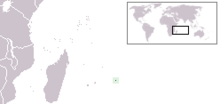| Rodrigues solitaire Temporal range:
| |
|---|---|

| |
| 1708 drawing by François Leguat, the only known illustration of this species by someone who observed it alive[1] | |
| Scientific classification | |
| Domain: | Eukaryota |
| Kingdom: | Animalia |
| Phylum: | Chordata |
| Class: | Aves |
| Order: | Columbiformes |
| Family: | Columbidae |
| Subfamily: | Raphinae |
| Genus: | †Pezophaps Strickland, 1848 |
| Species: | †P. solitaria
|
| Binomial name | |
| †Pezophaps solitaria (Gmelin, 1789)
| |

| |
| Location of Rodrigues | |
| Synonyms | |
|
List
| |
The Rodrigues solitaire (Pezophaps solitaria) is an extinct flightless bird that was endemic to the island of Rodrigues, east of Madagascar in the Indian Ocean. Genetically within the family of pigeons and doves, it was most closely related to the also extinct dodo of the nearby island Mauritius, the two forming the subfamily Raphinae. The Nicobar pigeon is their closest living genetic relative.
Rodrigues solitaires grew to the size of swans, and demonstrated pronounced sexual dimorphism. Males were much larger than females and measured up to 75.7–90 centimetres (30–35 inches) in height and 28 kilograms (62 pounds) in weight, contrasting with 63.8–70 centimetres (25–28 in) and 17 kilograms (37 lb) for females. Its plumage was grey and brown; the female was paler than the male. It had a black band at the base of its slightly hooked beak, and its neck and legs were long. Both sexes were highly territorial, with large bony knobs on their wings that were used in combat. The Rodrigues solitaire laid a single egg that was incubated in turn by both sexes. Gizzard stones helped digest its food, which included fruit and seeds.
First mentioned during the 17th century, the Rodrigues solitaire was described in detail by François Leguat, the leader of a group of French Huguenot refugees who were marooned on Rodrigues in 1691–1693. It was hunted by humans and introduced animals, and was extinct by the late 18th century. Apart from Leguat's account and drawing, and a few other contemporary descriptions, nothing was known about the bird until a few subfossil bones were found in a cave in 1786. Thousands of bones have subsequently been excavated. It is the only extinct bird with a former constellation named after it, Turdus Solitarius.
- ^ Cite error: The named reference
HumeSteel2013was invoked but never defined (see the help page). - ^ BirdLife International (2016). "Pezophaps solitaria". IUCN Red List of Threatened Species. 2016: e.T22690062A93259685. doi:10.2305/IUCN.UK.2016-3.RLTS.T22690062A93259685.en. Retrieved 12 November 2021.
